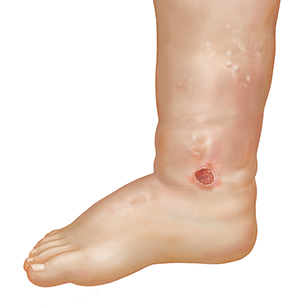Chronic Venous Insufficiency: Treating Ulcers
Chronic Venous Insufficiency: Treating Ulcers

Treating an ulcer
Visit your healthcare provider. Ulcers need frequent medical care. Special dressings may be applied. You may be given antibiotics to fight infection.
Your healthcare provider may prescribe medicines, such as aspirin or pentoxifylline, to help the ulcer heal.
Your healthcare provider may prescribe compression hose to help with the swelling.
Elevate your legs often to reduce swelling. The ulcer needs oxygen-rich blood to heal. This blood can’t reach the ulcer until swelling is reduced.
When to call your healthcare provider
Seek immediate medical attention if:
You have an increase in pain
You develop a fever of 100.4°F (38°C) or higher, or as directed by your healthcare provider
The area around the ulcer becomes red, tender, or both
The ulcer oozes discolored fluid or smells bad
Swelling increases suddenly or the dressing feels tight
Updated:
March 20, 2017
Sources:
Diagnosis and Treatment of Venous Ulcers. Collins, L. American Family Physician. 2010, is. 81, ed. 8, pp. s989-996., Medical Management of Lower Extremity Chronic Venous Disease. UpToDate
Reviewed By:
Mancini, Mary, MD,Sather, Rita, RN